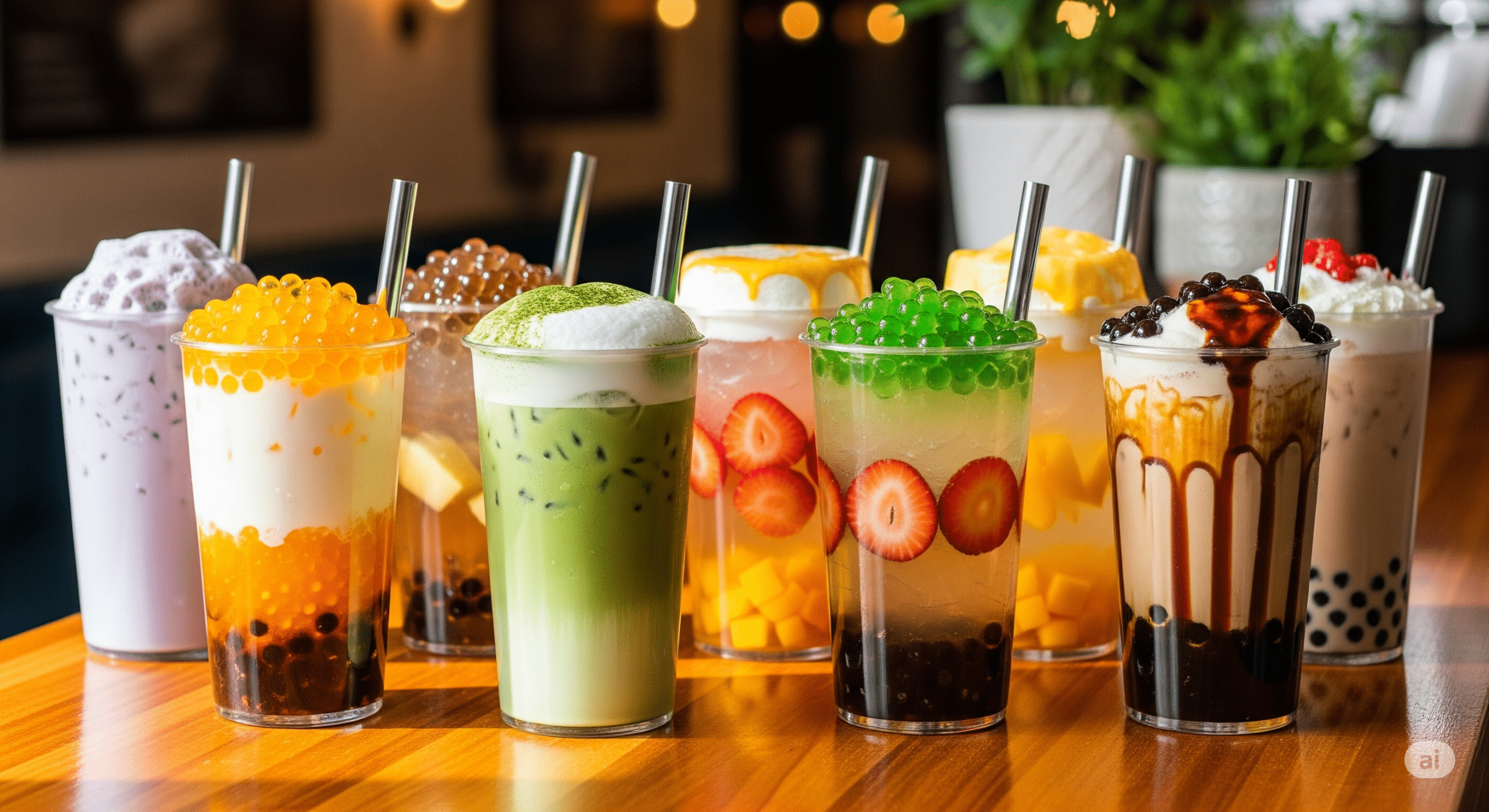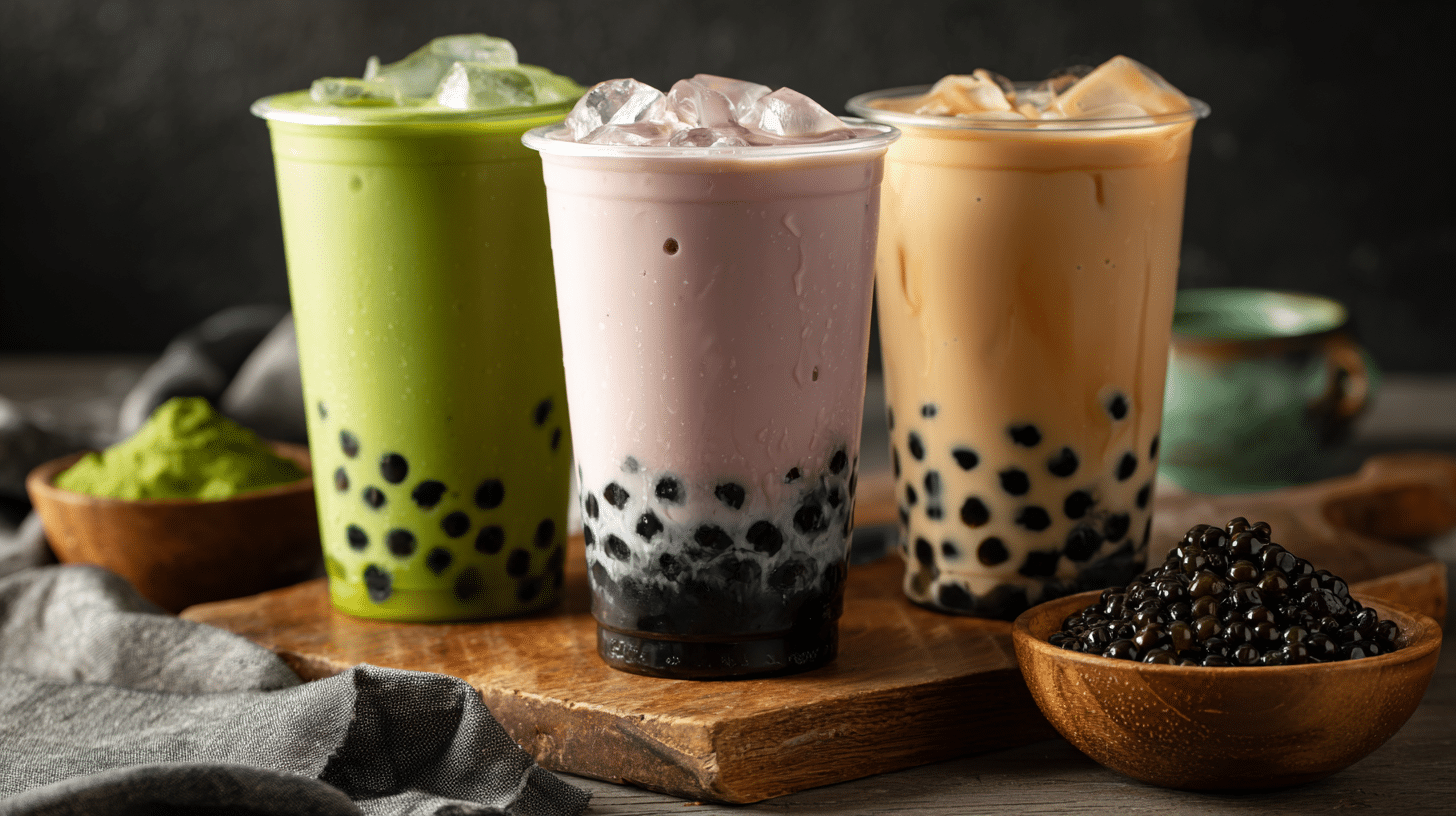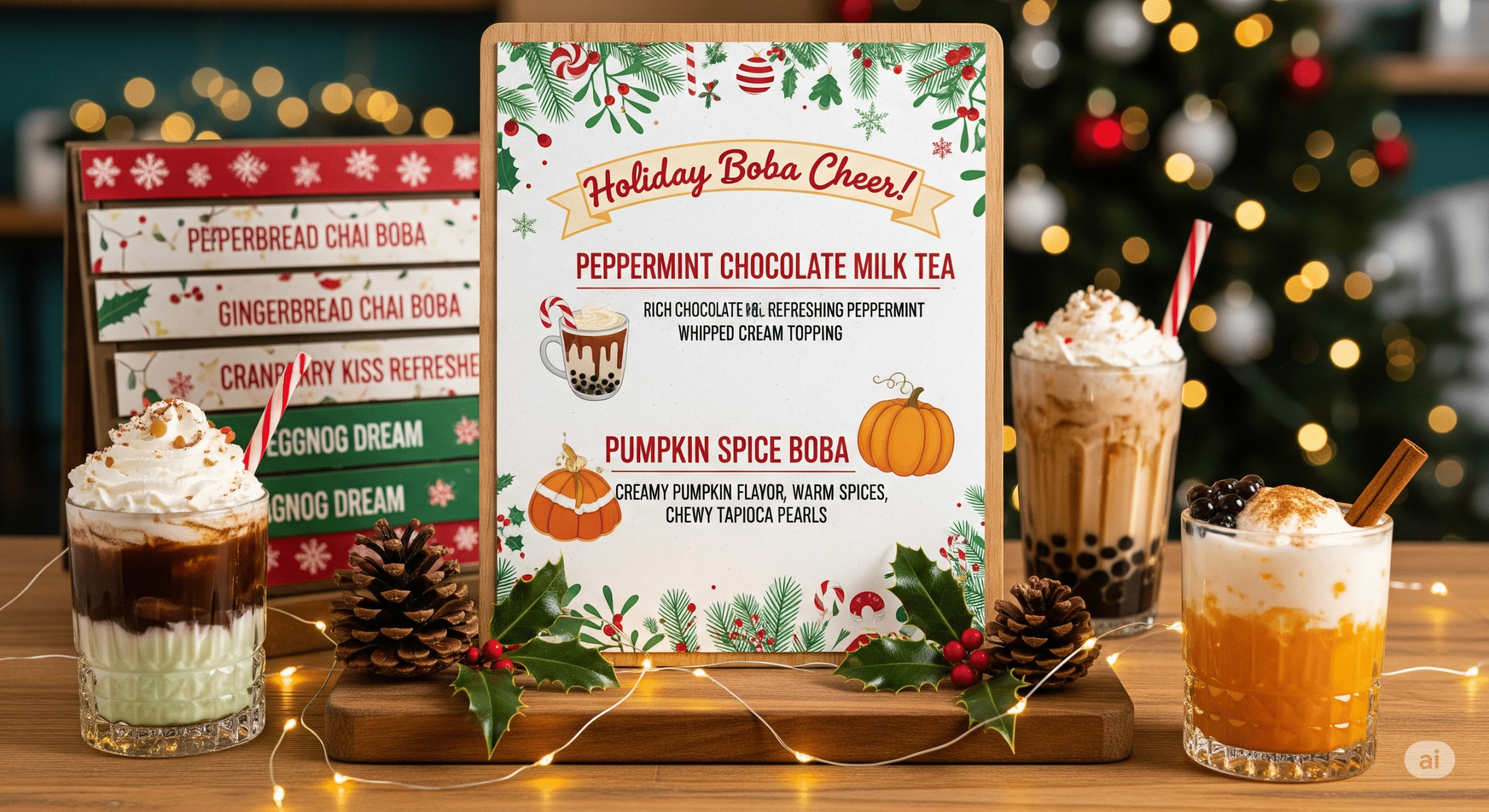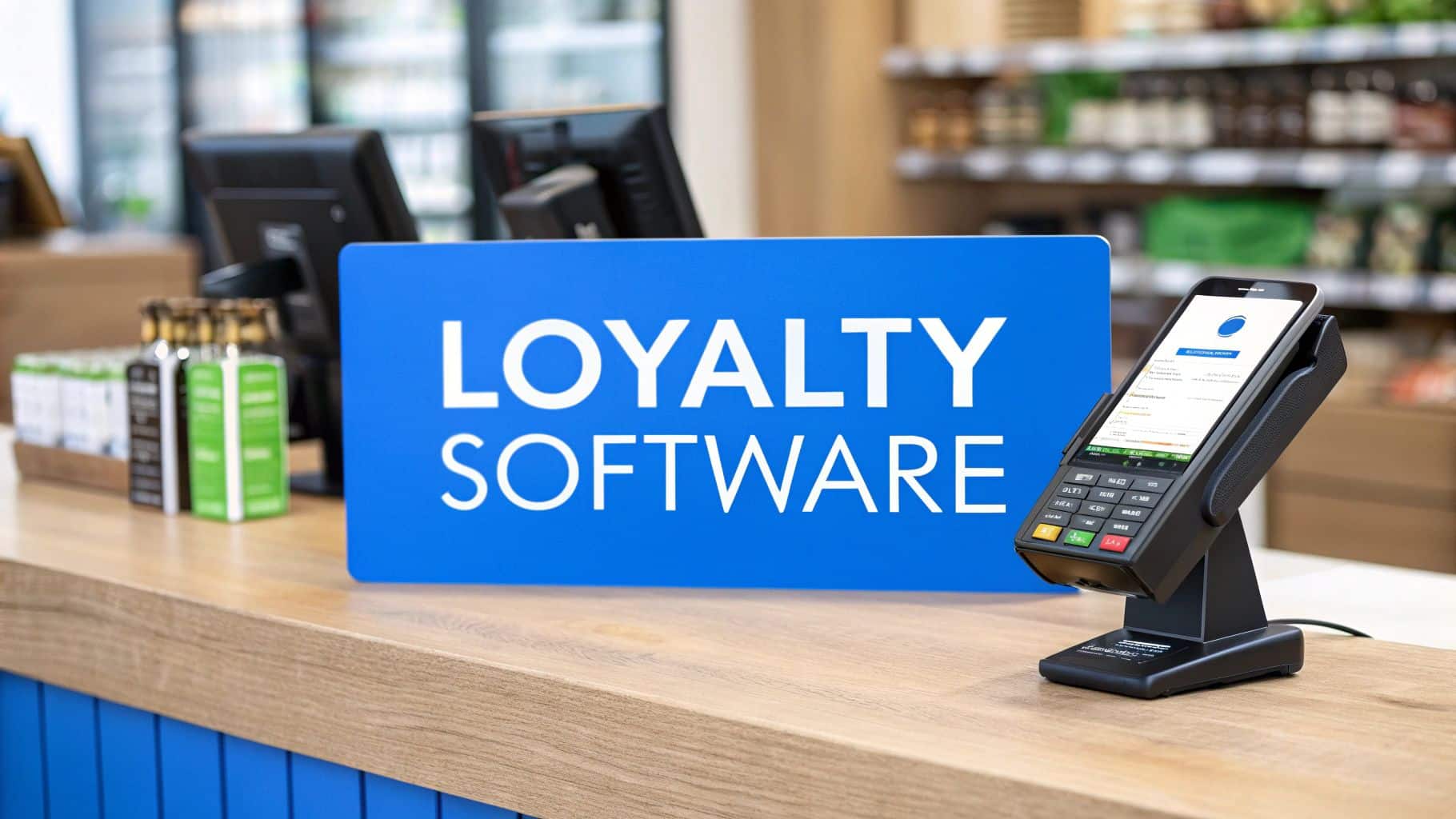Bubble tea has taken the world by storm, evolving from a simple milk tea drink in Taiwan to an international phenomenon enjoyed by millions. A well-crafted bubble tea menu offers far more than just tea and tapioca pearls; it’s a dynamic combination of flavors, textures, and choices that appeal to a wide range of customers. Whether someone is craving a creamy taro boba, a refreshing fruit tea, or a dairy-free option, the menu is the foundation of the bubble tea experience. Understanding the structure of a bubble tea menu is essential for both shop owners and tea lovers who want to explore every possibility.
Table of Contents
- Classic Milk Tea Options
- Refreshing Fruit Tea Flavors
- Creative Bubble Tea Toppings
- Customization and Specialty Drinks
- Seasonal Specials and Pairings
Classic Milk Tea Options
The heart of any bubble tea menu starts with its milk tea options. These drinks provide the perfect balance of creaminess and tea flavor, setting the standard for the entire menu. Each variety brings a unique taste and character, making it easy for customers to find their go-to choice.
Traditional Black Milk Tea
Traditional black milk tea is often considered the cornerstone of the bubble tea menu. Its popularity stems from its perfect balance of robust black tea and creamy milk, creating a drink that feels comforting yet sophisticated. Customers are drawn to this classic option because it delivers consistency — every sip carries a rich tea flavor that pairs beautifully with sweetness. For beginners, black milk tea often serves as an introduction to the world of boba, which explains why nearly every tea shop highlights it as a top-selling option.
When tapioca pearls are added, black milk tea transforms from a simple beverage into a cultural icon. The chewy pearls provide a delightful contrast to the smooth liquid, turning the act of drinking into an interactive experience. Many shops elevate their black milk tea with roasted oolong or Assam blends, creating deeper flavor notes that cater to more refined palates. This versatility makes black milk tea both accessible to newcomers and appealing to long-time enthusiasts who appreciate subtle variations.
Black milk tea’s appeal also lies in its adaptability. Customers can adjust sweetness, add flavored syrups, or pair it with dessert items for a more indulgent experience. For shop owners, offering consistent, high-quality black milk tea builds trust with customers and sets the standard for the rest of the menu. It’s more than just a drink — it’s the foundation on which a successful bubble tea menu is built.
Taro Boba and Its Creamy Appeal
Taro boba is instantly recognizable for its vibrant purple color and unique flavor profile. Unlike black milk tea, taro is naturally sweet and nutty, with subtle vanilla notes that make it taste more like a dessert. Its creamy texture appeals to customers who prefer a rich and indulgent drink, making it one of the most ordered options worldwide. The combination of taro and milk creates a velvety smoothness that resonates with both children and adults, ensuring broad appeal.
Beyond flavor, taro’s visual appeal contributes significantly to its popularity. Customers love sharing photos of their purple drinks, which often leads to free marketing for tea shops on social media platforms. Taro bubble tea is also highly versatile when paired with toppings such as pudding, grass jelly, or coconut jelly, which enhance its dessert-like qualities. For those who enjoy experimenting, taro boba can be blended into smoothies for a thicker, milkshake-like experience.
An important factor in taro’s success on the bubble tea menu is its inclusivity. Many shops prepare it with non-dairy creamers, making it accessible to customers with lactose intolerance or those seeking vegan-friendly options. This flexibility ensures that taro remains a reliable favorite across different dietary preferences, cementing its place as a must-have item on any bubble tea menu.
Matcha Latte and Green Tea Variations
Matcha latte has become a global sensation, and its presence on the bubble tea menu reflects growing demand for healthier alternatives. Matcha, made from finely ground green tea leaves, is known for its earthy flavor and energizing properties. When paired with milk and sweetener, it creates a balanced drink that appeals to both traditional tea drinkers and health-conscious customers. Its vibrant green color also adds visual intrigue, making it stand out on the menu.
What makes matcha particularly appealing is its versatility. It can be enjoyed hot during colder months or iced for a refreshing summer treat. Shops often experiment by layering matcha with flavors such as strawberry, vanilla, or coconut, producing specialty drinks that attract repeat business. For customers who enjoy more subtle flavors, green tea variations like jasmine milk tea or genmaicha milk tea provide lighter alternatives without sacrificing depth.
In addition to flavor, matcha and green tea-based drinks position themselves as functional beverages. Customers often choose them for their antioxidant benefits and natural energy boost, setting them apart from sweeter dessert-style options. This health-forward appeal ensures that green tea variations remain a permanent and profitable category within any bubble tea menu.
Refreshing Fruit Tea Flavors
While milk teas form the base of a bubble tea menu, fruit tea flavors bring vibrancy and freshness. They appeal to customers who prefer lighter, caffeine-free options, making them a great alternative for kids or those avoiding dairy. Fruit teas also offer seasonal opportunities to highlight local produce and trendy flavor pairings.
Citrus-Based Iced Teas
Citrus-based iced teas provide a refreshing contrast to heavier milk teas and are among the most popular categories on a bubble tea menu. Drinks like lemon green tea or orange black tea deliver a crisp, tangy flavor profile that customers crave during hot weather. Their lightness makes them an excellent choice for those seeking hydration with a flavorful twist, ensuring wide customer appeal.
One reason citrus teas are consistently popular is their ability to pair well with various add-ons. For instance, honey can be used as a natural sweetener to balance tartness, while toppings like aloe vera jelly or popping boba enhance the drinking experience with extra textures. Customers often enjoy experimenting with these combinations, which encourages repeat visits and builds long-term loyalty.
From a business perspective, citrus teas are cost-effective since lemons, oranges, and limes are widely available year-round. This ensures that shops can consistently meet demand without the risk of seasonal shortages. By featuring citrus iced teas prominently, shop owners strengthen their bubble tea menu with reliable crowd-pleasers that deliver both freshness and profitability.
Tropical Fruit Tea Selections
Tropical fruit teas bring an exotic flair to the bubble tea menu, instantly transporting customers to a vacation-like experience. Flavors such as mango, passionfruit, and pineapple are bold and vibrant, offering refreshing alternatives to traditional milk teas. These options are especially appealing in summer when customers crave cooling beverages packed with natural sweetness and tartness.
Mango green tea is a prime example of a tropical favorite. Its sweetness blends harmoniously with the mild bitterness of green tea, creating a balanced drink that feels both indulgent and refreshing. Passionfruit teas, on the other hand, offer a tangy complexity that pairs well with popping boba, while pineapple teas add a playful tropical twist that excites adventurous palates.
Beyond taste, tropical teas also shine in terms of presentation. Their bright colors and layered appearances make them highly photogenic, driving organic promotion through social media shares. For shop owners, this visual appeal translates into increased brand awareness and customer traffic. Including tropical teas on a bubble tea menu ensures both flavor diversity and marketing value.
Berry-Flavored Refreshments
Berry-based teas such as strawberry, blueberry, and raspberry are staples on a bubble tea menu due to their wide-ranging appeal. Their sweet-tart flavor profiles strike a balance that pleases both children and adults, making them versatile options across demographics. When combined with fruit-based popping boba, berry teas become even more exciting, offering bursts of flavor with every sip.
Shops often experiment by blending berries with other fruits, creating signature combinations like strawberry passionfruit tea or blueberry lemonade green tea. These innovative pairings differentiate one shop from another, encouraging customers to explore and return for new experiences. Seasonal berries also provide opportunities for limited-time offerings, which drive urgency and boost sales.
Berries pair particularly well with desserts, making them excellent candidates for combo deals. A strawberry fruit tea alongside a cheesecake creates a balanced flavor experience that customers appreciate. By strategically positioning berry drinks within their menu, shops not only meet customer demand but also open avenues for cross-promotions and upselling opportunities.
Creative Bubble Tea Toppings
Toppings are what transform a basic tea drink into an interactive and exciting bubble tea experience. A well-designed bubble tea menu must highlight toppings clearly, since customers often customize their drinks around these add-ons. From chewy to crunchy, toppings define the personality of each order.
The Classic Tapioca Pearls
Tapioca pearls are the quintessential topping that gave bubble tea its global identity. Made from cassava starch, these chewy pearls add a unique texture that distinguishes bubble tea from other beverages. Their neutral flavor absorbs sweetness from syrups and teas, ensuring they complement a wide variety of drinks. For many customers, ordering a bubble tea without tapioca pearls simply feels incomplete.
Consistency is key when preparing pearls. Undercooked pearls are too hard, while overcooked ones become mushy, leading to customer disappointment. Shop owners must perfect cooking techniques to maintain the ideal chewiness, which customers expect from every cup. Some shops innovate further by offering mini pearls or pearls infused with flavors like brown sugar, giving customers exciting alternatives to the classic version.
Tapioca pearls also carry cultural significance. Originating in Taiwan, they remain a symbol of authenticity in bubble tea culture. By keeping tapioca pearls as a central topping option, shops not only preserve tradition but also meet customer expectations for the complete bubble tea experience.
Popping Boba for a Fun Twist
Popping boba introduces a playful element to the bubble tea menu. Unlike tapioca pearls, these juice-filled spheres burst in the mouth, releasing fruity flavors instantly. Available in varieties such as mango, lychee, and strawberry, popping boba appeals especially to younger customers who enjoy novelty and excitement in their drinks.
These toppings pair particularly well with fruit teas, enhancing freshness while adding bursts of sweetness. Their colorful appearance also creates Instagram-worthy drinks, helping shops attract attention online. For shop owners, the visual appeal and interactive experience of popping boba make it an easy upsell that boosts revenue.
Popping boba also broadens the customer base by appealing to those who dislike the heaviness of tapioca pearls. Customers who want a lighter, more refreshing topping option often gravitate toward popping boba. Including this choice on a bubble tea menu ensures inclusivity and variety, making the shop attractive to a wider audience.
Jelly and Pudding Toppings
Jellies and puddings provide additional variety on the bubble tea menu by offering contrasting textures and flavors. Coconut jelly, grass jelly, and aloe vera jelly each bring a refreshing quality that pairs well with fruit teas. Their slippery texture creates a smooth contrast against the chewiness of pearls, giving customers layered experiences with every sip.
Puddings, such as egg or chocolate pudding, enhance drinks with creaminess and richness. These toppings appeal to customers who enjoy dessert-like beverages and pair exceptionally well with milk teas like taro or matcha. Offering puddings allows shops to cater to customers who want indulgent treats alongside their drinks.
The addition of jellies and puddings also increases customization opportunities. Customers can mix and match toppings to create drinks tailored to their preferences, which enhances engagement and loyalty. By prominently featuring these toppings on the bubble tea menu, shops demonstrate creativity and commitment to delivering diverse options.
Customization and Specialty Drinks
One of the main reasons bubble tea continues to grow in popularity is the freedom it gives customers to customize their drinks. A strong bubble tea menu must clearly highlight customization options while also showcasing signature specialty drinks that make the brand stand out.
Customizable Sugar and Ice Levels
One of the most defining aspects of bubble tea culture is the ability for customers to control sugar and ice levels. This customization allows each drink to be tailored to personal preferences, creating a sense of ownership over the final product. Sugar levels typically range from 0% to 100%, with increments that provide nuanced sweetness. Health-conscious customers often appreciate the ability to reduce sugar without sacrificing the overall flavor experience.
Similarly, ice levels can be adjusted based on customer needs and seasonal factors. For example, during colder months, many prefer drinks with less ice or opt for hot boba drinks, while in summer, extra ice creates a more refreshing experience. These adjustments may seem small, but they significantly enhance customer satisfaction and build loyalty. A customer who feels their drink is “just right” is far more likely to return.
For shops, offering these customization options signals flexibility and attentiveness to customer needs. Highlighting sugar and ice level adjustments on the bubble tea menu also prevents confusion, ensuring customers feel confident in ordering exactly what they want. This small detail is a powerful driver of repeat business.
Signature Drinks and Specialty Creations
Signature drinks set one bubble tea shop apart from another and are often the highlight of any bubble tea menu. These creations showcase the shop’s creativity by combining unique flavors, toppings, and presentations that customers cannot find elsewhere. For example, a shop might feature a brown sugar milk tea with caramelized streaks along the cup, creating a visually striking and indulgent beverage.
Other specialty drinks may blend categories, such as smoothie-style bubble teas that combine fresh fruit with milk tea bases. These drinks often become the most photographed and shared items, generating buzz both in-store and online. Signature creations not only attract curious first-time customers but also inspire loyalty among those who make these drinks their regular orders.
Highlighting specialty drinks on the menu positions a shop as an innovator rather than a follower. Customers often view signature creations as a reason to choose one tea shop over another, making them critical for brand identity. By carefully curating and promoting these drinks, shop owners can ensure they remain memorable in a competitive market.
Dairy-Free and Vegan Bubble Tea Options
As dietary preferences shift toward plant-based lifestyles, dairy-free and vegan options have become essential components of a modern bubble tea menu. Using alternatives such as oat milk, almond milk, or coconut milk ensures that customers who avoid dairy can still enjoy creamy and flavorful drinks. This inclusivity not only expands the potential customer base but also positions a shop as responsive to evolving food trends.
Dairy-free options are also appealing to lactose-intolerant customers, who may otherwise feel excluded from enjoying milk teas. By offering these choices, shops eliminate barriers and create welcoming environments for all customers. Vegan toppings like fruit jellies and plant-based creamers further support this inclusivity, making it easy for customers to craft fully vegan bubble tea experiences.
From a marketing perspective, promoting vegan-friendly drinks on the bubble tea menu can attract eco-conscious customers who prioritize sustainability. This strategy not only increases revenue but also builds a positive brand image. By emphasizing dairy-free and vegan options, shops demonstrate their commitment to diversity and customer satisfaction.
Seasonal Specials and Pairings
To keep a bubble tea menu exciting and relevant, shops often introduce seasonal specials and curated pairings. These limited-time offerings create urgency and encourage customers to visit more frequently, ensuring consistent engagement throughout the year.
Holiday-Themed Creations
Holiday-themed bubble teas add festive excitement to the menu and align shops with customer celebrations. Drinks like peppermint chocolate bubble tea in winter or pumpkin spice milk tea in autumn tap into widely popular seasonal flavors. These offerings not only attract attention but also help shops stand out in competitive markets during high-demand periods.
Presentation plays an equally important role in holiday specials. For instance, adding red and green jellies for Christmas or heart-shaped popping boba for Valentine’s Day creates a memorable experience. Customers often share these festive drinks on social media, generating organic buzz and boosting visibility.
Seasonal drinks also create anticipation and loyalty. Customers begin to associate certain holidays with returning to their favorite bubble tea shop, which strengthens long-term relationships. By consistently innovating around holidays, shops can make their menus feel fresh and celebratory year after year.
Combo Deals and Dessert Pairings
Combo deals are an effective way to increase average ticket size while enhancing customer satisfaction. By pairing bubble tea with snacks like egg waffles, mochi donuts, or savory buns, shops create complete meal experiences rather than just drinks. These deals appeal to customers who want both a beverage and a treat in one purchase, making them particularly popular during social outings.
Dessert pairings also highlight the versatility of bubble tea. Creamy milk teas complement salty snacks, while tart fruit teas balance well with rich desserts like cheesecakes. Offering suggested pairings directly on the bubble tea menu provides guidance for customers and encourages upselling opportunities, boosting profitability for the shop.
From a branding perspective, combo deals position a shop as a destination for social gatherings. Customers are more likely to meet friends at a place that offers drinks and snacks together, increasing foot traffic and customer loyalty. By curating thoughtful pairings, shops create memorable experiences that go beyond the drink itself.
Limited-Time Seasonal Ingredients
Introducing drinks made with seasonal ingredients is one of the most effective ways to keep a bubble tea menu dynamic. Fresh strawberries in spring, lychee in summer, or chestnut in winter bring variety and exclusivity to the menu. These drinks feel special because they’re tied to a specific time of year, which drives urgency and repeat visits.
Local sourcing adds another layer of appeal to seasonal offerings. By highlighting partnerships with nearby farms, shops can market their drinks as fresh and sustainable. This resonates with customers who value quality and community support, strengthening the shop’s overall brand image.
Seasonal flavors also act as testing grounds for permanent additions. If a limited-time drink becomes highly popular, it can be incorporated into the main menu later. This strategy allows shops to innovate without risk, ensuring they remain ahead of trends while satisfying evolving customer preferences.
Why a Strong Bubble Tea Menu Matters
A carefully structured bubble tea menu does more than list drink options—it defines the customer experience. From milk tea classics to fruit tea innovations and creative toppings, the menu reflects the shop’s identity and ability to adapt to trends. Customers return not only for flavors but also for the ability to customize and experiment. For shop owners, this means designing a menu that balances tradition with innovation while catering to diverse dietary needs.
At Biyo POS, we understand how important a strong bubble tea menu is for business success. Our all-in-one POS system makes it easy to update menu items, track seasonal specials, and manage ingredient inventory in real time. With AI-powered ordering and integrated payments, Biyo POS helps bubble tea shops deliver seamless customer experiences while boosting efficiency. By combining technology with creativity, shop owners can keep their menus fresh and their customers satisfied.
FAQ
What makes a bubble tea menu successful?
A successful bubble tea menu balances classic favorites like milk tea with creative seasonal offerings. It also provides customization options for sugar, ice, and toppings, ensuring customers can personalize their drinks. Clear organization and visual appeal make the menu easy to navigate, helping customers choose confidently.
What toppings should always be on a bubble tea menu?
Tapioca pearls are essential, as they define the bubble tea experience. Popping boba, jellies, and puddings add variety and excitement. Offering multiple topping choices encourages customers to experiment and return for different combinations.
How often should bubble tea menus change?
While core items should remain consistent, seasonal specials should be updated quarterly to keep the menu exciting. Limited-time offerings create urgency and boost customer engagement. Shops should also monitor trends, introducing popular new flavors when demand is high.






